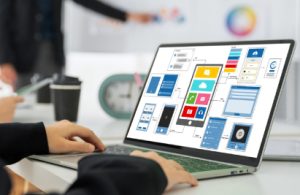As a Framework:
Flutter App Development:
- Flutter Software Development Kit (SDK) powered by Dart
- A framework with reusable UI components known as widgets
Why Flutter's Popularity Is on the Rise?
Constant collaboration between Google and the Flutter community ensures ongoing enhancements to Flutter, enabling users to effortlessly create stunning, cross-platform, and natively compiled mobile applications. The preference for Flutter over other platforms and native app development sources can be attributed to various factors:
➤ Reduced development costs
➤ Lower maintenance costs (especially advantageous for costly apps, which may benefit from being rewritten in Flutter)
➤ A unified codebase for multiple platforms, including iOS, Android, web, and more.
Beyond its primary role in building cross-platform apps, Flutter serves as a versatile tool for various purposes. While its main focus remains on creating mobile, web, and desktop apps from a single codebase, Flutter extends its capabilities to several areas where it excels:
Cross-Platform Mobile Applications: Flutter easily facilitates the creation of visually appealing, high-quality, and performant mobile applications for both iOS and Android platforms. The use of a single codebase helps developers save resources and accelerate time to market.
Multi-Page or Single-Page Applications: Flutter is adept at building both single-page and multiple-page applications for the web, providing a responsive and fast user interface for the development of engaging and interactive applications.
Desktop Application Development: Flutter’s potential has expanded beyond mobile and web platforms to desktop environments. Developers can use the framework to build desktop applications for Windows, macOS, and Linux, ensuring native-like experiences across various operating systems.
PWAs (Progressive Web Apps): Flutter supports the development of Progressive Web Apps that offer native-like experiences. These apps can be installed on a user’s device, enhancing performance, providing app-like functionalities, and offering offline support.
Simple 2D-Game Development: Flutter can be employed for developing 2D games and other interactive experiences. The framework’s rendering engine, coupled with an impressive set of animation and UI capabilities, makes it suitable for creating lightweight games with added gamified elements. While options for 3D rendering are currently limited, future versions of Flutter are expected to introduce significant improvements.
Prototyping and MVP Development: Flutter’s customizable widgets, fast development cycle, and exceptional reload features make it an ideal choice for prototyping and minimum viable product (MVP) development. This streamlines the development life cycle, allowing apps to reach users more quickly.
IoT and Embedded Systems: Flutter can be utilized to create user interfaces for IoT devices and embedded systems. Its ability to run on different platforms makes it flexible enough to develop interfaces for wearables, smart devices, home automation systems, and other connected devices.
Discover The Benefits of Flutter App Development:
Having explored the intricacies of Flutter technology, emphasizing its strengths and substantial impact on the development industry becomes crucial. This empowers users to make well-informed decisions for their ongoing software development endeavours.
For Flutter App Development Companies, key advantages include
➤ Expedited mobile application development processes.
➤ Lowered costs associated with mobile app development.
➤ Superior performance of cross-platform mobile applications built using Flutter compared to other cross-platform frameworks.
➤ The framework’s exceptional architecture, delivers unparalleled UI capabilities.
🡆 Unified Codebase for Multiple Platforms
Flutter simplifies the development process by adhering to the ‘develop once and use it everywhere’ principle. Utilizing the Dart programming language, developers can write code once and deploy the application seamlessly on iOS, Android, web, and desktop platforms. This not only expands the reach to diverse user bases but also saves time and effort by eliminating the need for a fresh codebase for each platform.
🡆 Native-Like Performance
The framework’s architecture is meticulously designed for high performance. Leveraging Dart as a compiled programming language and Impeller as a high-performance rendering engine, Flutter ensures smooth and responsive app development, akin to the experience with native apps.
🡆 Accelerated App Development
A standout feature of Flutter apps is the Hot Reload functionality, providing a distinct edge over other apps. This feature significantly expedites app development by allowing immediate code changes to be reflected. This collaboration-friendly feature brings designers and developers together, enabling real-time cosmetic adjustments that yield impressive results.
It’s worth noting that Google developers introduced the Hot Reload feature to enhance application productivity, a feature highly appreciated by today’s app developers.
🡆 Cost-Effective Development
The cross-platform nature of Flutter app development translates into a cost-effective venture. Flutter developers excel in maintaining a single codebase for iOS and Android platforms, eliminating the need for separate development teams. This not only reduces development time and effort but also streamlines the overall process, lowers maintenance costs, and enables businesses to target a broader audience without the expenses of building and maintaining two separate applications.
🡆 Swift Time to Market
Developing code once and deploying it across multiple platforms empowers Flutter developers to expedite their time-to-market. This unified approach eliminates the necessity for creating distinct codebases for each platform. The Hot Reload feature enables real-time changes, facilitating faster app refinement and rapid iterations. While each app update requires review in Apple or Google app stores, as is the case with other frameworks, Flutter’s capabilities allow architecture-level changes to be introduced swiftly, expediting subsequent steps in the development process.





